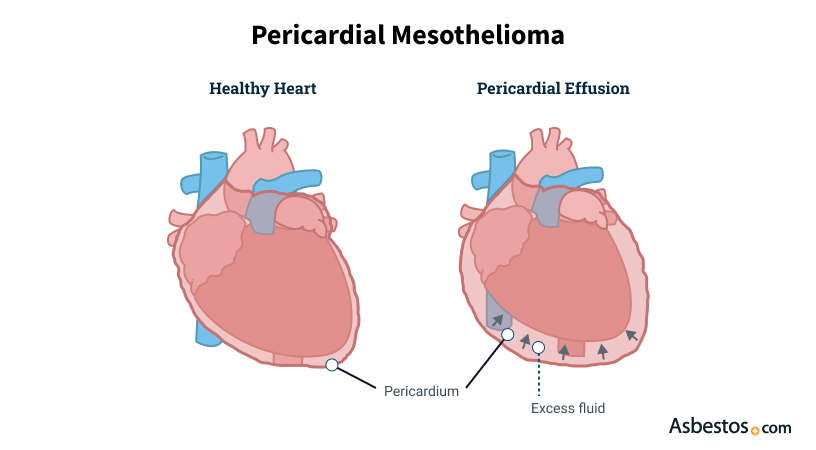Pericardial Effusion
Pericardial effusion is an accumulation of excess fluid between the layers of the sac that surrounds the heart. It is a primary symptom of pericardial mesothelioma. Treatments are available to remove the fluid and prevent recurrence.
Written by Karen Selby, RN | Medically Reviewed By Dr. Jeffrey Velotta | Edited By Walter Pacheco
Asbestos.com is the nation’s most trusted mesothelioma resource
The Mesothelioma Center at Asbestos.com has provided patients and their loved ones the most updated and reliable information on mesothelioma and asbestos exposure since 2006.
Our team of Patient Advocates includes a medical doctor, a registered nurse, health services administrators, veterans, VA-accredited Claims Agents, an oncology patient navigator and hospice care expert. Their combined expertise means we help any mesothelioma patient or loved one through every step of their cancer journey.
More than 30 contributors, including mesothelioma doctors, survivors, health care professionals and other experts, have peer-reviewed our website and written unique research-driven articles to ensure you get the highest-quality medical and health information.
About The Mesothelioma Center at Asbestos.com
- Assisting mesothelioma patients and their loved ones since 2006.
- Helps more than 50% of mesothelioma patients diagnosed annually in the U.S.
- A+ rating from the Better Business Bureau.
- 5-star reviewed mesothelioma and support organization.
Testimonials
My family has only the highest compliment for the assistance and support that we received from The Mesothelioma Center. This is a staff of compassionate and knowledgeable individuals who respect what your family is experiencing and who go the extra mile to make an unfortunate diagnosis less stressful. Information and assistance were provided by The Mesothelioma Center at no cost to our family.LashawnMesothelioma patient’s daughter
How to Cite Asbestos.com’s Article
APA
Selby, K. (2024, February 2). Pericardial Effusion. Asbestos.com. Retrieved May 17, 2024, from https://www.asbestos.com/mesothelioma/pericardial/effusion/
MLA
Selby, Karen. "Pericardial Effusion." Asbestos.com, 2 Feb 2024, https://www.asbestos.com/mesothelioma/pericardial/effusion/.
Chicago
Selby, Karen. "Pericardial Effusion." Asbestos.com. Last modified February 2, 2024. https://www.asbestos.com/mesothelioma/pericardial/effusion/.
What Causes Pericardial Effusions?
Mesothelioma tumors growing on the heart lining (pericardium) may cause pericardial effusion.
Other causes of pericardial effusion include:
- Pleural mesothelioma or other cancers of the chest
- Inflammation of the heart lining
- Bacterial, viral, fungal or parasitic infection
- Certain chemotherapy drugs such as doxorubicin and cyclophosphamide
- Radiation therapy
- Underactive thyroid
- Inflammation
- Infection
- Other primary cancers of the chest

Pericardial effusion is a common symptom of pericardial mesothelioma. It is a rare cancer that forms in the lining of the heart.
This lining, known as the pericardium, contains two layers. A small amount of fluid exists between these layers. It lubricates the lining and offers protection around the heart.
What Are the Symptoms of Pericardial Effusions?
Not everyone with pericardial effusion will experience symptoms.
Symptoms of pericardial effusion include:
- Shortness of breath or breathing difficulties
- Uncomfortable breathing while lying down
- Chest pain (often on the left side)
- A sense of fullness or pressure in the chest
Excess fluid can increase pressure on the heart, a condition called cardiac tamponade. This prevents the chambers from filling. Poor circulation and inadequate oxygen supply result.
Treatment for pericardial effusion involves minor or major surgical procedures.
Pericardial Effusion Treatment
Procedures that treat this condition drain the fluid or remove the lining.
Pericardiocentesis
A pericardiocentesis is a minor surgical procedure. It drains fluid from around the heart.
Process of a Pericardiocentesis
- Application of a local anesthetic.
- A heart ultrasound guides insertion of a thin needle into the pericardial lining.
- A catheter replaces the needle.
- The catheter drains the excess fluid, which may take several hours.
There is a chance the fluid could return after a pericardiocentesis. A pericardiectomy to prevent recurrence helps patients with recurring pericardial effusion.
Pericardiectomy
A pericardiectomy is a surgery that removes part or all the heart lining. It treats pericardial effusion, inflammation of the pericardium (pericarditis) and pericardial mesothelioma. A pericardial window is another term for the procedure.
There are two types of pericardiectomies:
- A partial pericardiectomy removes a diseased part of the heart lining.
- A total pericardiectomy removes all the lining.
The surgery prevents fluid from accumulating again. Recovery in the hospital takes one to two weeks.
Connect with Our Community

Get in Touch
Have a question? Contact one of our Patient Advocates and get the answers you need.

Join Our Support Group
Connect, share stories and learn from the experiences of others coping with mesothelioma in one of our support groups.

Giving Back
We help support charities, hospitals and awareness groups working to help people impacted by asbestos and cancer.







